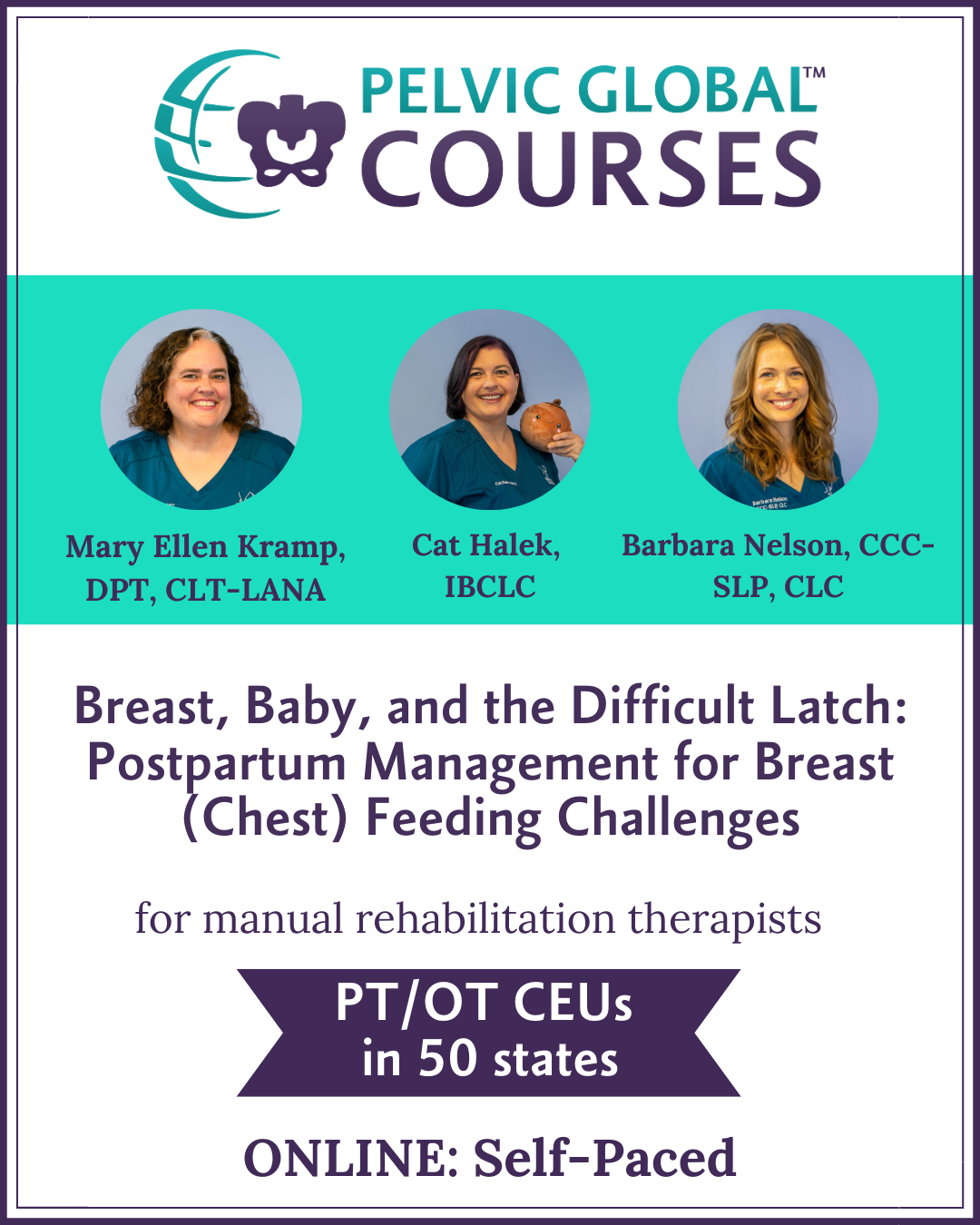Breast, Baby, and the Difficult Latch: Postpartum Management for Breast (Chest) Feeding Challenges

This course offers an in depth knowledge of:
- the anatomy, physiology, and biomechanics involved in breastfeeding
- practical strategies for addressing common issues that affect both the mother and infant which impact breastfeeding
What to expect:
Throughout the course, physical & occupational therapists will learn to apply evidence-based practices, work collaboratively, and use hands-on techniques to help breastfeeding mothers and infants achieve optimal comfort, function, and breastfeeding success. This course is suitable for physical and occupational therapists and assistants who work in outpatient, inpatient, or home health settings, and those seeking to enhance their knowledge and skills in this specialized area of care.
Basic hand skills will be taught for evaluation and treatment of the fascia, lymphatics, and vasculature of the breast; as well as evaluation of the infant’s posture, trunk, neck, and oral structures as it impacts the suck.
The course also includes important considerations for working with this specialized population such as normal developmental milestones and behaviors of the newborn and how to support new parents.
What will you learn?
At the completion of this course, participants will be able to:
Identify the anatomy of the breast in different planes.
Identify the anatomy of the infant’s oral and pharyngeal cavities.
Describe the process of sucking and swallowing.
Describe the process of lactogenesis.
Understand the anatomy of the latch.
Understand the importance of communication for the breastfeeding dyad.
Recognize the “green flags” (normal expected course) with breastfeeding.
Discuss various diagnoses that affect the breast and impact breastfeeding.
Understand the roles of various practitioners in treating the breastfeeding dyad to implement in practice.
Perform mechanical evaluation and treatment of the breast.
Perform the mechanical evaluation and treatment of the baby struggling to feed.
Recognize signs which indicate referral of the infant and/or mother for further support.
Mary Ellen Kramp, DPT, CLT-LANA
Education is another passion. She is the owner of Fluid PT, a continuing education company for therapists. She has also co-founded The Nourish Project to create professional and community education from a multidisciplinary standpoint for the treatment of breast/bottle feeding infant issues and mastitis. In 2014 she became the president and co-founder of Pelvic Health Research Initiative, a non-profit organization established to raise money to fund pelvic research. Through her companies she has developed her own continuing education courses to teach Lymph Drainage and Vascular Release for the Pelvic PT, Lymph & Vascular Techniques for the Ortho Therapist, The Infertility Protocol, Pelvic PT Primer, and Breast, Baby & The Difficult Latch.
On top of treating numerous diagnoses and creating educational programs, she also has an interest in research. She published a case series report in the Journal of the American Osteopathic Association on manual therapy techniques for the treatment of infertility and has also published in Rehabilitation Oncology. A randomized, controlled pilot study on treating infertility has recently closed.
Cat Halek, IBCLC
Barbara Nelson, CCC-SLP, CLC
A passionate educator, Barbara co-founded The Nourish Project, where she develops and delivers interdisciplinary continuing education courses for healthcare providers nationwide. Her lecture experience includes topics on breastfeeding dyad assessments, treatment approaches for feeding issues, and fostering collaborative care. She has presented at large conferences, such as the Tampa Bay Breastfeeding Task Force Annual Conference and the National APTA Conference.
Through her work, Barbara combines clinical acumen with an unwavering commitment to teaching and advocacy, ensuring both providers and parents are equipped with the tools to nurture healthy feeding practices from the start.

